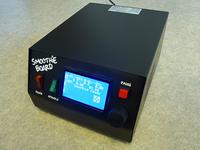A CNC router
Having been a happy Dremel owner for more than a decade already, I am well aware of the joy in finding all kinds of objects hidden inside slabs of wood and plastic. Only problem is that it's somewhat imprecise to cut them out of their solid prison when operating the tool just by hand. To that end, I decided to buy a CNC mill/router.
My budget was "under 1000 EUR" and I wanted to be able to carve atleast plastic and preferrably aluminum also. Within these constraints, I considered Proxxon MF70 and Shapeoko 2. What I finally bought, however, is a Chinese CNC 3020 variant.
There is preciously little information about this device available online. A major source of confusion is the different models: mine is a CNC 3020T-DJ bought from eBay. It is supposed to have "new spindle", but it does not have ball screws like the CNC 3020Z+D52 does. Overall, the generic feel on internet forums seems to be that the control electronics are poor and the spindle not that great either.
One commenter on Hackaday said it was "essentially a CNC dremel". Well, that should be just what I need.
I'm going to upgrade mine to run on Smoothieboard to avoid the need for a PC and parallel port. I'm also going to build some kind of sound insulating enclosure. Follow the progress below.
First impressions on the CNC 3020
So, I ordered a CNC 3020T-DJ. Surprisingly, the "Free shipping" on the eBay item turned out to be UPS delivery, which only took 10 days to arrive from the day I ordered. Weight of the package was 22.5 kg, and I estimate that shipping was about 200 USD out of the 750 USD total cost.
Smoothieboard conversion
The original electronics on CNC3020 are a blast from the past. Designed to be driven from a parallel port using realtime PC, it has just three TB6560AHQ stepper drivers and a big heatsink. I didn't feel like having a desktop PC just for this, so I replaced the driver board with a Smoothieboard.
Noise isolation box
Using a CNC router in an apartment has a few limitations, namely noise and chips. To contain these, I built an insulated, air-tight box. To further make it fit in with the furniture, the lid is upholstered and acts as a bench.



